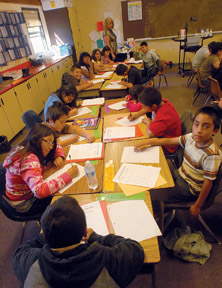While the Hollister School District’s budget for 2013-14 is still in flux as trustees await decisions at the state level about funding, the district’s restoration committee has prepared to present a list of priorities to the school board before the end of April with suggestions on services they would like to see restored if funding levels begin to increase.
The restoration committee, formed at the beginning of the 2012-13 school year, includes teachers, administrators, classified staff and members of the community who shared their thoughts on how the district should proceed when revenue figures improve. With the approval of Proposition 30 by state voters last fall, local schools are not anticipating budget cuts this year, though they are still unsure if there will be additional funds available in the coming fiscal year. The committee members met over the course of the past year and prepared a report that is expected to be discussed at a special district board meeting at 4 p.m. April 23.
“The restoration committee will have made it clear to the board what the recommendations are from this fairly heterogeneous group,” said Hollister School District Superintendent Gary McIntire, of the committee that included more than 35 members. “It will come down to the board, ultimately, in making the decision.”
The restoration committee looked at areas where recent budget cuts have eliminated or scaled back services in the Hollister School District such as reducing instructional days, increasing classroom sizes, and eliminating middle school sports and library services, among other items. They ranked 21 potential areas to restore when funding becomes available. In a report released March 26, McIntire revealed the first-tier list of priorities, along with some dollar amounts reflecting the annual cost.
“When we used a system for determining the interest of the group and did a vote-by-dot kind of a process … it was pretty clear when we started looking at where people went that some stood out really quickly,” McIntire said.
The highest priority for the group is increasing annual instruction to 180 days, the traditional number for most elementary and middle schools.
“If we have more days to teach kids we have the opportunity for more access to students. … We’d like to get back to 180 days, instructionally,” McIntire said, of the district’s elimination of five teaching days as a cost-saving measure. “The associations (unions) acknowledge the lost work days – they’d like to get those back.”
McIntire said some other items such as restoring the school sports program and the music program, which has been funded through a community fundraising effort, were also high on the list of priorities.
But many of the top priorities focused on academics.
“When you compare that (instructional days) with some of the other things out there, say afterschool sports, we said, ‘Gosh, academics is our core mission,’” McIntire said. “While we like to have afterschool sports programs, it’s harder to balance those programs with the instructional mission of the district.”
Other high priorities included lowering class sizes, with a focus starting in kindergarten as well as restoring libraries at all schools, starting at 50 percent staffing levels.
The committee estimated the cost per each additional instructional day at $170,000 for a total cost of $850,000 annually to restore the academic year to a full 180 days.
The cost to lower class sizes is $60,000 per student per grade level. The cost to restore library technicians at all the sites is $270,000 per year.
McIntire said the amount of money the Hollister School District will receive is largely still up in the air, as they await the state’s May revision on May 15. The method in which money is allocated to school districts may be changing for the 2013-14 school year in efforts to make distribution more equitable, based on demographics.
Gov. Jerry Brown’s budget proposes a local control funding formula that would provide school districts with a per pupil base grant, with supplemental grants available for each English learner, economically disadvantaged or foster youth in the district. Schools with more than 50 percent of those enrolled falling into one of those categories would receive additional funding. McIntire said the district staff is still awaiting a decision on whether the formula would go into effect for the 2013-14 budget year and how it would impact the local budget in the first year of a five-year transition.
The anticipation is that Hollister School District would receive more funding because of a high concentration of some students who fall into the categories identified for additional funding.
“That, by itself, means California schools will see a redistribution of funds,” McIntire said. “On top of that, the state budget is looking better. But we won’t know until we get the May revise.”
While McIntire’s staff submitted a request for layoff notices to go out to 33.94 full-time equivalent teachers at a March 5 special board meeting, the board of trustees voted 3-2 against accepting the layoffs.










